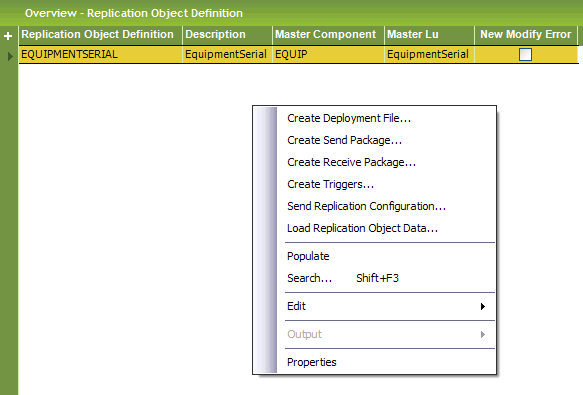

Replication Object Definition contains the basic data describing all the Replication Objects, i.e. objects that can be replicated to other sites and/or objects that can receive replicated data from other sites. Although this information should be supplied at install time it is possible to define replication objects at a specific site.
The operations available in this window are:
|
Operations |
Description |
|---|---|
|
Create Deployment File |
use this to create a file containing the selected Replication Object Definition
data. A dialog box is opened where you enter an Output
File Name. Use file names like {ReplicationObjectName}.ins. |
| Create Send Package | use this to create two files containing the PL/SQL package specification
and body for sending data belonging to the selected Replication
Object. A dialog box is opened and where you enter two input
Template Names, Template_BOS.api/apy
and two output Source File Names, {ReplicationObjectName}_BOS.api/apy. |
|
Create Receive Package |
use this to create two files containing the PL/SQL package specification
and body for receiving data belonging to the selected Replication
Object. A dialog box is opened where you enter two input
Template Names, Template_BOR.api/apy
and two output Source File Names, { ReplicationObjectName
}_BOR.api/apy. |
|
Create Triggers |
use this to create a file containing the triggers used for sending data
belonging to the selected Replication Object. A dialog box is opened where you
enter an input Template Name, Template_BO_TRG.cre
and an output Source File Name, { ReplicationObjectName
}_BO_TRG.cre. |
|
Send Replication Configuration |
use this to create a Connectivity message containing the replication configuration. The message is sent to the receiver(s) and is installed in the replication repository on the receiver. A dialog box is opened where you enter a Receiver or a Replication Group. If no value is entered, the created message is sent to all receivers. |
|
Load Replication Object Data |
use this to initiate a download of data to a receiver. A dialog box is opened
where you enter a Replication Group and a
Logical Unit.
If no value is entered for the replication group, data is loaded to all replication groups configured to receive data from the Replication Object. If no value is entered for the logical unit, all logical units in the Replication Object are loaded. It is also possible to enter a date for Rows Changed Since and a Commit Interval. If no value is entered for rows changed since all rows is loaded. If no value is entered for commit interval a commit is issued on each 100 rows. |
Standard operations enabled in the toolbar: New, Remove, Modify
This window contains:
Replication Object Definition: includes Replication Object Definition information. The overview only contains the replication object master record information. The complete information is shown in the detail form.
Master Component: is used only to narrow the selection in the LOV on the Master Lu column.
Master LU: is the master logical unit in the replication object.
New Modify Error: controls the behavior when a received message state that the operation at the replicator site is New/Modify and the object is already present/not present in the database. If the checkbox is marked, an error is raised when operation is New and the object already exists or when the operation is Modify and the object donít exist. If the checkbox is not marked, no error condition is raised and the object is inserted or updated.